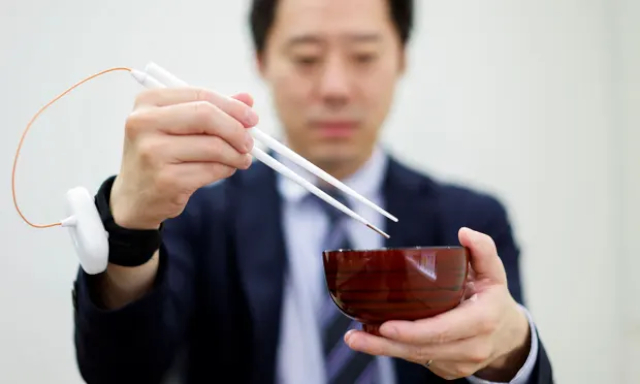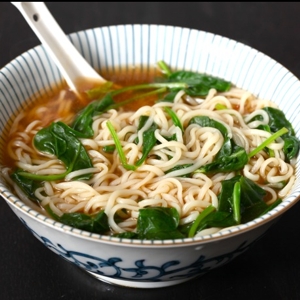Up to now, research on getting packaged and processed food manufacturers to reduce the added salt in their products has focused on other ways to make the foods more tasty – alternative seasonings, boosted herbs and spices. Now Japanese inventors are thinking outside the food…
 Electric chopsticks prototype, powered by a wrist-worn micro-computer…
Electric chopsticks prototype, powered by a wrist-worn micro-computer…
We’ve long been aware that Asian cooks tend to add more salt to their food than their western counterparts. And they have long used a salt cousin, MSG, to boost their diners’ flavour experience. MSG, of course, is also based on sodium – the main constituent of salt, and the central villain in the eternal battle against high blood pressure and other cardiac-related ills.
No surprise, then, that it was a team of Japanese inventors who come up with a new way to get the salt sensation on your palate without adding salt to your food.
Yes, it’s digital
And like so many new personal health monitoring and treatment devices, it’s worn on your wrist, like a FitBit. The difference is, there’s a wire that leads from your wrist to your chopsticks.
That wire delivers a digitally-generated impulse to your mouth that simulates the sensation you get when you taste salt. The way it does that sounds deceptively simple: it pushes natural sodium ions (free sodium) out of the food you’re eating so they effect your palate the same way as salt would.
“[The chopsticks use] very weak electricity – not enough to affect the human body – to adjust the function of ions such as sodium chloride and sodium glutamate to change the perception of taste by making food seem to taste stronger or weaker,” Japanese food and beverage manufacturer Kirin said in a statement.
A real, palpable need
Reducing salt intake by Japanese consumers is a top-level concern for the medical and food manufacturing establishments. According to a recent Guardian article, “The average Japanese adult consumes about 10 grams of salt a day, double the amount recommended by the World Health Organization. The [Japanese] health ministry has proposed reducing daily salt intake to a maximum of 7.5 grams for men and 6.5 grams for women.”
As you might have guessed, much of that excess salt comes from two ubiquitous, traditional cooking ingredients – miso and soy sauce, which are basically umami- and salt- delivery systems. Maybe Asian cooks of all national cuisines will be able to use less of those in future, thanks to the electric chopstick.
A broader application
While they’re at it, inventor Homei Miyashita, a professor at Meiji University in Tokyo, and his team should consider building their salt impulse deliverer into a fork. I can see millions of western diners who’d buy one to help reduce their added-salt intake. But would the Fast Food folks and the sit-down restos agree to offer low-salt versions of their menu items tuned to complement the effects of device? I hope they do.
~ Maggie J.

